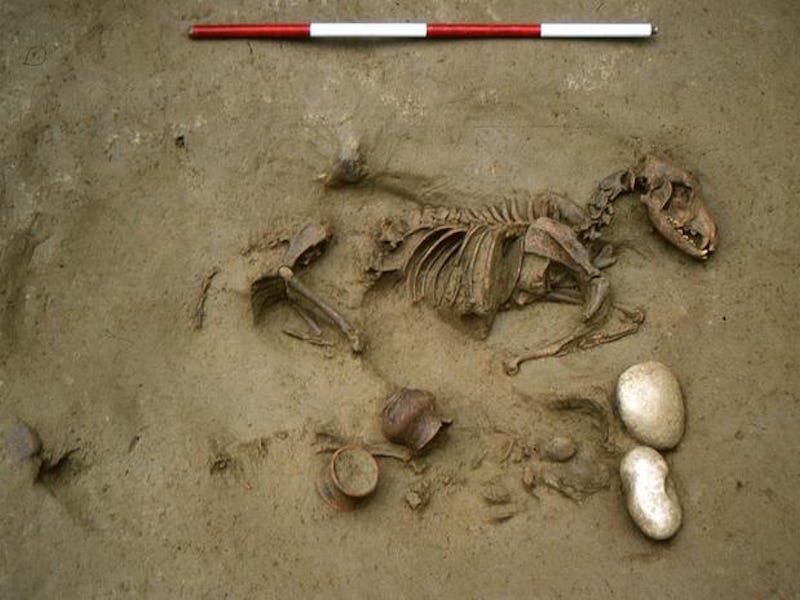A Celtic Burial Site In Verona Reveals Ancient Italians Buried With Their Pets
When love for your four-legged friend runs six feet deep.

You may think you love your steadfast dog or persnickety cat, but is it true love unless you’re buried together?
For ancient Europeans of northern Italy, that enduring devotion did indeed run six feet deep, at least according to a study published Wednesday in the journal PLOS One.
In a Celtic burial site in Verona, Italy, dating as far back as the third century B.C., archaeologists discovered animals buried alongside human remains. Some animal remains, like cows, pigs, and chickens, may have been sustenance for the afterlife. But others, like horses and dogs, were likely loyal companions following their owners in death or part of an elaborate funerary rite observed among other Celtic cultures during the late Iron Age.
A joint burial of a dog and a human. Photo by S.R. Thompson, courtesy of SABAP-VR Soprintendenza archeologia, belle arti e paesaggio per le province di Verona, Rovigo e Vicenza.
Joint tombstones
Since their domestication thousands of years ago, dogs and horses have always been held in high regard for their cultural, religious, and economic utility. Their co-burial with humans has been well-documented. For instance, the remains of the Bonn-Oberkassel dog in Germany, dating back 14,000 years ago, were buried alongside a man and woman. A man and his puppy, dating over 12,000 years ago, were buried in a grave discovered in northern Israel and associated with the Natufian people.
Horses, being the majestic creatures they are, also received special treatment. In a site along the Nile River called Tombos — in what is now Sudan — a former chariot-pulling horse was honored with a human-style tomb over 3,000 years ago, a post-mortem privilege typically granted to high-ranking officials. The Celts, who spread throughout Western Europe and even had a horse deity named Epona, kept their four-legged beasts close even in death, as evidenced by one grave of an Iron Age warrior discovered in Yorkshire, England.
Buried in place
In 2005, during the construction of an underground garage in the main courtyard of the Bishop's Seminary at Verona, archaeologists uncovered a cemetery belonging to the Cenomani, an ancient group of Celts who lived in northern Italy during the third to the first centuries B.C.
Over the next four years, the remains of over 160 individuals — a mix of mostly children of various ages and adults — were exhumed. A majority of the individuals were buried alone and accompanied by some grave goods like pottery, coins, rings, and a knife or two. Sixteen of the graves, however, contained animal remains. Thirteen contained what the archaeologists believe were food offerings of pig, cow, or chicken (some snails were found, but it’s unlikely ancient Celts were dining on escargot — those probably snuck into the graves somehow). Three other graves, including one from the 13, contained either fully intact or parts of dogs and/or horses.
These individuals include a middle-aged man with a small dog, a young boy between ages 10 to 17 buried with horse bone, a female infant laid beside a dog, and a middle-aged woman between ages 35 and 50 with a whole horse plopped right on top of her. This last grave also contained bones from other horses, a dog skull, cow bones, and the remains of an unrelated infant.
Considering that dog and horse meat weren’t on the menu for these ancient folk, the archaeologists say it’s likely co-burial with these animals held some sort of religious or cultural meaning or an indication of affection.
"It is tempting to cautiously postulate an association between the deposition of this animal and their association to the underworld,” the authors write in their paper. “A link between dogs and the afterlife can be found throughout time and space, with examples from ancient Egypt, Scandinavia, classical, and Gallo-Roman culture.”
One of the dogs found with the middle-aged man ate an omnivorous diet common to prehistoric hunting dogs, based on its bone collagen ratio. On the other hand, the dog found with the female infant was fed a special diet that appeared to be low in animal protein and high in carbohydrates. The researchers say this may indicate the dog was a sacrificial animal offered when the baby died, so it was put on a special diet. Another theory is that since it had a broken leg, the diet may have been related to its convalescence.
Interestingly, genetic analysis revealed none of these individuals were related to one another, suggesting this practice of co-burial with dogs and/or horses wasn’t specific to one or another family. However, the lack of a consistent pattern makes it hard to say from whom this practice arose — whether from the Celts or other regional groups.
Whatever the reason, it just comes to show love for our pets has and will always transcend the bounds of time.